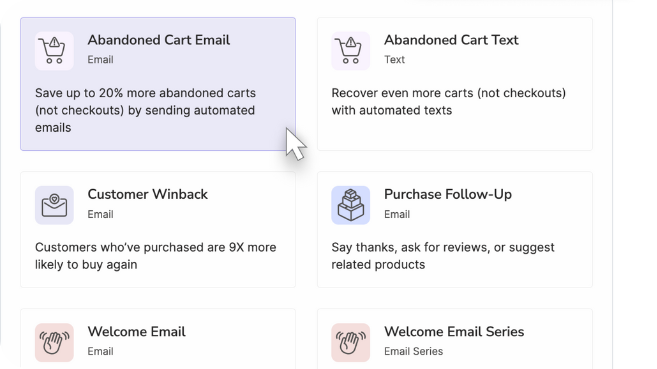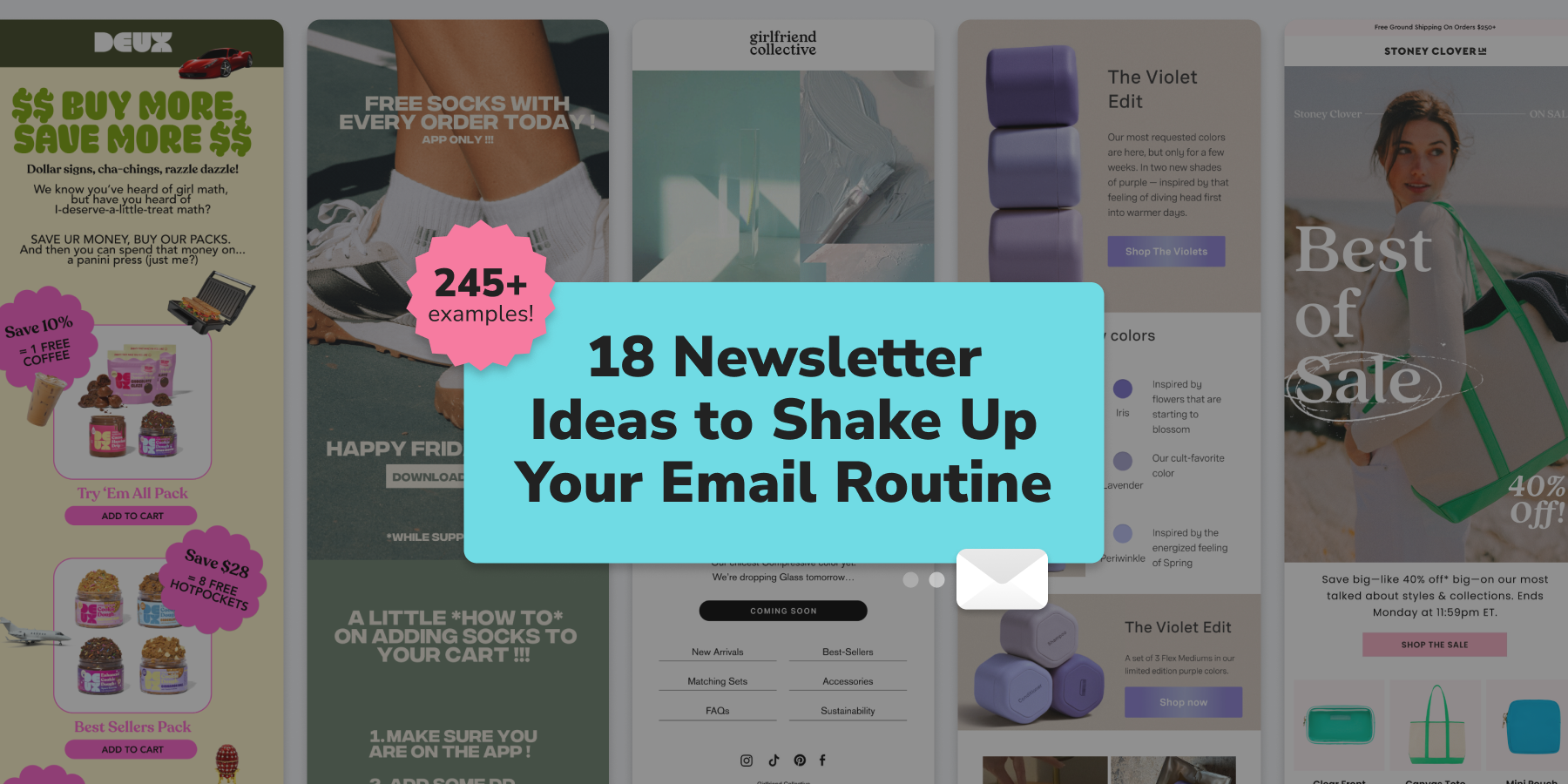Email Marketing Ecommerce Brands Ecommerce Marketing
What To Offer In A Cart Recovery Campaign: 9 Secrets For Turning Browsers Into Buyers
8 min read time
Published on Jun 23, 2020
Written by Rachel Waldmann

Let me paint you a picture: you’re browsing an online store. You’ve found something that makes your heart happy, but you know you can live without it. You decide to think it over, see if you really want it. Or you decide you’re not willing to pay $3.99 shipping on a $240 purchase. Or you get distracted with the latest plot twist in the show you’re watching. Or your kid knocks over their juice, for the fourth time today. Or...the list goes on.
There are endless reasons why shoppers abandon their carts. The truth is, you can have a phenomenal user experience, a product people rave about, and masterful marketing to boot.
But it’s human nature to leave a shopping cart behind; in fact, an estimated 70% of shopping carts are abandoned! So if you’re not doing what you can to save that sale, you’re missing out on a whole lot of potential revenue.
But there’s good news too! You can combat the dreaded abandoned cart in the form of your email marketing. And it works. Statistics show that 45% of abandoned cart emails are opened, 21% are clicked, and 50% of those clicks lead to a recovered purchase.
To make my point, I went and abandoned a bunch of carts, and found some prime examples of best practices. Here are 9 tips for crafting an abandoned cart email series that will reel your customers back in and help recover more abandoned carts.
Get our best content on ecommerce marketing in your inbox 2 times a week
1. Remind them what they’ve left behind
Abandoned cart emails are sent to shoppers who have added items to their cart but have not completed the checkout process. You’ll want to send your first email within a few hours of the customer leaving your website, but even in that short period of time, you’ve lost some of their attention. That’s why a visual reminder in your email will be critical in recapturing their interest. Product images may trigger a reminder of why they loved the item in the first place, in hopes that they’ll fall in love all over again.
This email from Jeni’s Splendid Ice Creams reminded me what ice cream flavors I left sitting in my cart. Guess what happened next. I immediately wished I had some ice cream (even more than usual).
Remember that people frequently make purchases based on their hearts and guts, and in this instance, mine told me that I needed a delicious frozen treat.
 2. Great copy matters
2. Great copy matters
Every touchpoint you have with your customers is an opportunity to express your brand voice, and sell them on it. You put effort into your welcome emails and marketing newsletters, so it only makes sense that you’d put that same effort into an abandoned cart email too.
Make your words count by using an attention-grabbing subject line, and a clear and powerful call-to-action. Keep the text simple and friendly, but catchy, so that even with a reader’s short attention span, your message sticks.
Your subject line is your first impression, and it doesn’t even require the reader to open the email in order to see it. That’s why, if you’re including a discount or other offer, it helps to include it in the subject line, so it can’t be missed. Here are a few examples of subject lines that grab:
1. Did you forget about me?
2. Come back for free shipping
3. Use your 20% off soon!
4. We saved something for you!
5. Is your WiFi broken?
6. We’re ready when you are
Magic Spoon does an incredible job of using their energetic, lighthearted approach in every inch of their marketing emails:
3. Use urgency
Get your customers to pay attention to what they might miss out on by adding a sense of urgency. FOMO is a very real motivator.
Whether you’re reminding them that you’re only saving their cart for a short amount of time, their offer expires, or items are selling out fast, giving people limits and deadlines incentivizes them to act before it’s too late.
This email received from My Social Book is all about the time-sensitivity of their offer.

4. Make it personal
First and foremost, your customers are people. People often buy with their emotions, so a more personal email will likely be more engaging. For example, you might choose to flatter them by telling them they’ve got great taste, like the example below from Pela.
Alternatively, you can tailor your email to the customer by displaying a few other items they might be interested in, like the below email from Coconut Lane. Maybe they’re not totally sold on the particular item they’ve chosen, and a suggested alternative might be better. Or, maybe you’ll luck out and convince them to buy both! Just don’t overwhelm them with too many choices, since that could backfire, especially if they’re already on the fence about purchasing.
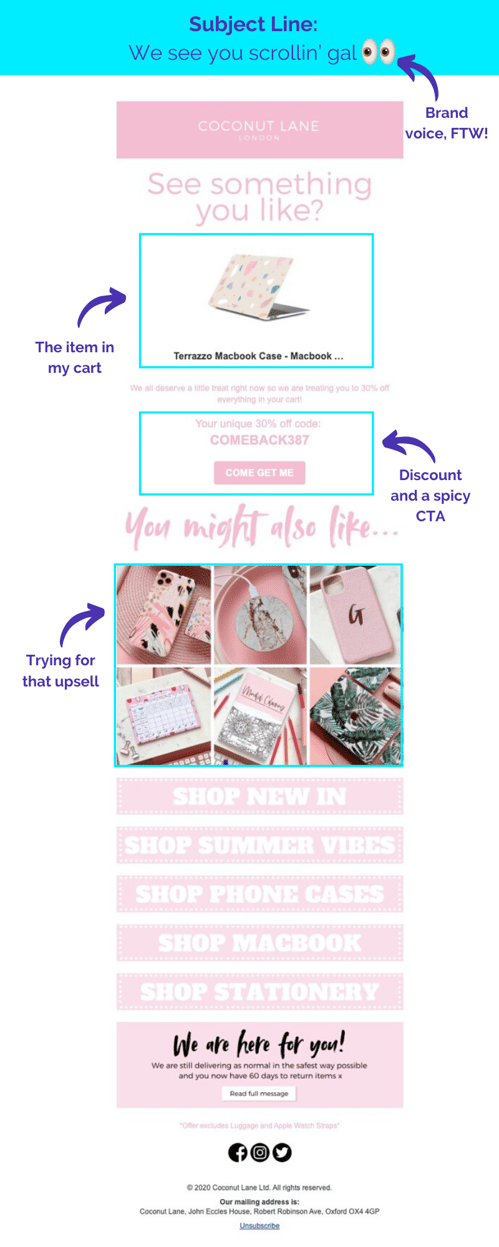
5. Offer a discount
Many customers abandon their cart because the final price gives them pause. They may not have thought about taxes or shipping costs. So if you’re able to, offer free shipping or a discount to sweeten the deal a little.
We understand that maybe your store can’t hand out discounts left and right. For that reason, it’s often worth saving the discount for later in your abandoned cart series. Consider trying some of the other tactics we’ve listed for your first email, then offer a discount or free shipping towards the end for those who are clearly not going to pay full price. A discounted sale is better than no sale at all, right?
Cape Clasp’s abandoned cart email not only has their discount featured front-and-center, but it was also right there in the subject line, which caught my attention before I even opened the email. And let’s be honest, if it doesn’t catch your customers’ attention, they may send your email straight to the trash.

7. Address objections
If customers aren’t buying, take the time to do the research and reflect on why this might be. Understanding why your customers specifically are abandoning their carts will help inform your marketing strategy.
Do they have questions about the product or your return policy? Maybe they’re not sure if your product is worth the extra money over a cheaper alternative on another site. Try to address these concerns head-on by acknowledging them and putting their minds at ease. Lori Wall Beds did just this by emphasizing that their beds can be tried risk-free.

8. Show social proof
Your products have good reviews? Nice. Proof or it didn’t happen. 91% of people read online reviews when considering a new purchase, so it’s critical to include social proof where you can, including as a boost to your marketing emails.
Leverage product reviews (like Lori Wall Beds did above), social media shout-outs for your brand, or testimonials (like The Baconer does in an upcoming example) in your abandoned cart emails to show your customers that they’ll be happy with their purchase.
1. A reminder 4 hours after the cart is abandoned.
2. A sense of urgency (and a discount if you can offer it) 24 hours after the cart is abandoned. (ex: “We saved your cart, but it’s selling out fast!” or “Here’s 15% off, but it expires in 24 hours.”)
(Sidenote: you can watch Ezra’s entire Introduction to Email Marketing for Small Ecommerce Brands course, too!)
You may opt to include a third and final email with a short (as in, like, 1 question) survey asking what prevented them from purchasing, or what you can do to improve for the future.
If after 3 attempts, your customer doesn’t come back and complete their purchase, it’s time to let it go. You don’t want your brand to reek of desperation, and you definitely don’t want to pester your contacts to the point where they unsubscribe from your emails altogether.
These examples from The Baconer were all part of the same series. Every email has some sort of bacon-inspired copy, and all three emails in the series tie into one another.
Email #1
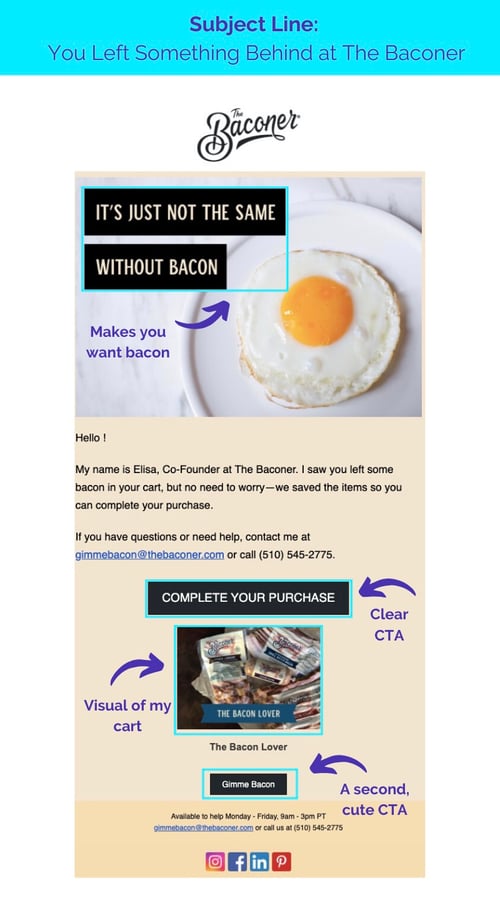
Email #2
 Email #3
Email #3

9. Integrate with other channels
Your abandoned cart emails can work in tandem with text message marketing to form a highly effective series. For instance, you can leverage SMS by shooting customers a text an hour after they abandon their cart to remind them to revisit, then follow up via email after 24 hours.
Death Wish Coffee started out their abandoned cart series with a text within an hour of leaving their checkout page. They then followed up a couple hours later with a similar (but not identical) email, reinforcing their brand and their message on multiple channels:

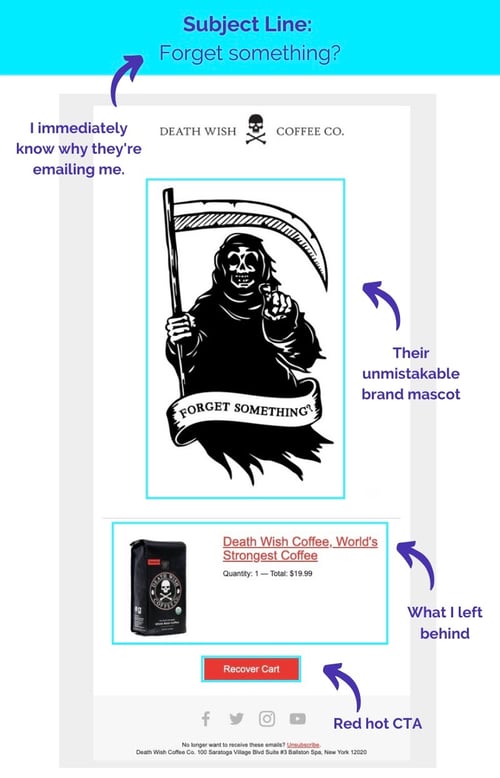
Takeaway: it's not all about discounts
Offering a discount isn't the only way to get results when it comes to recovering abandoned carts. Sometimes all it takes is a reminder that a purchase wasn't actually made.
Pair that with great copy, social proof, and some solid objection handling and you're on your way to converting those abandoned carts into actual sales (without dipping into your margins).
Subscribe for Updates
Get our best content on ecommerce marketing in your inbox 2 times a week.

Written by Rachel Waldmann
Subscribe for Updates
Get our best content on ecommerce marketing in your inbox 2 times a week.


.jpg)
